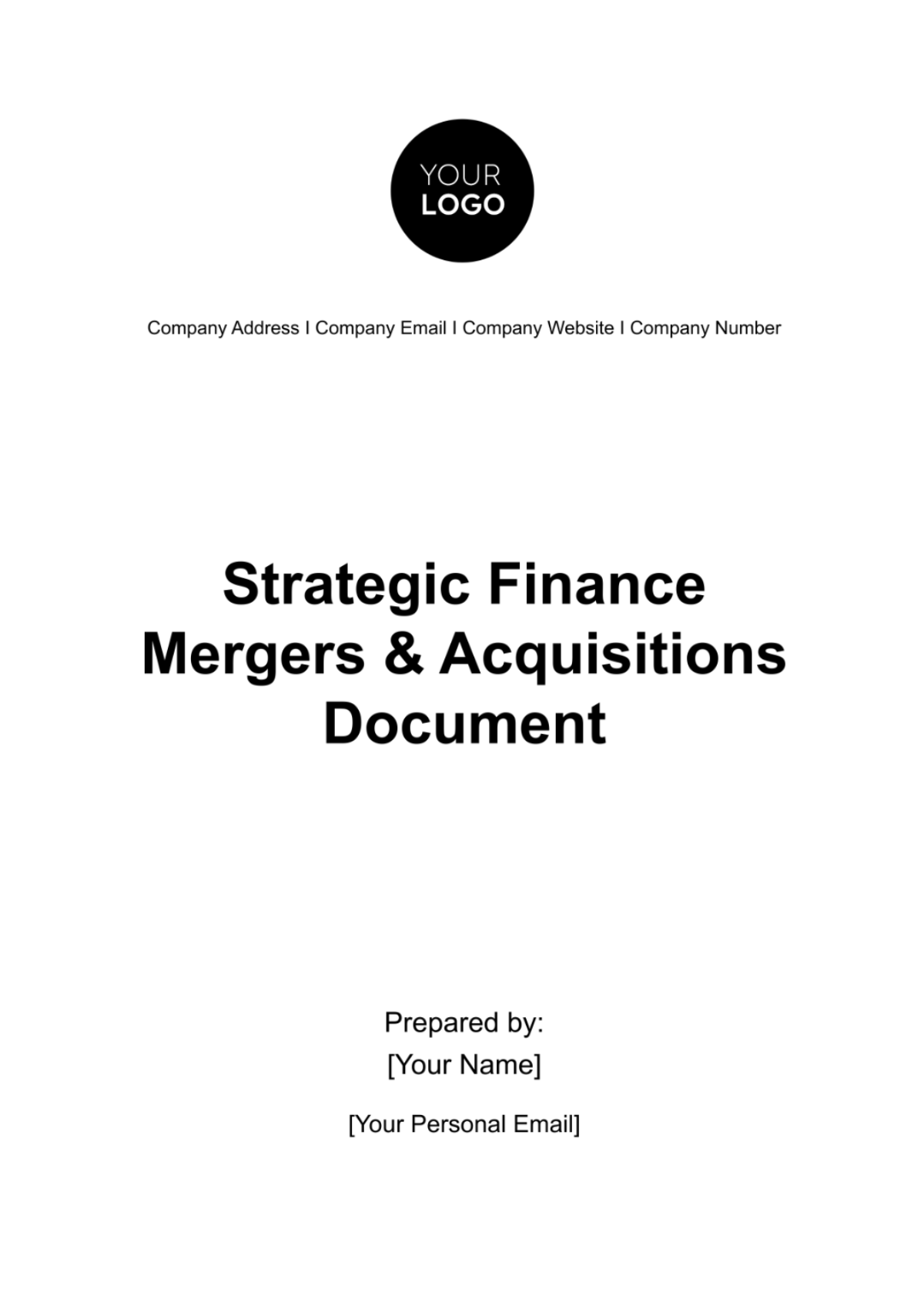Free Strategic Finance Mergers & Acquisitions Document

I. Executive Summary
This document aims to provide a comprehensive overview of the M&A transaction, outlining strategic objectives, and anticipated financial impact. This strategic endeavor aims to create a robust and competitive entity poised for sustained success in the dynamic business landscape. The M&A transaction is underpinned by a sound financial foundation, as indicated by the projected financial data. In the year 2060, the combined entity anticipates a revenue of $5,200,000 million, demonstrating a steady growth trajectory. Operating income is projected at $1,800,000 million, reflecting operational efficiency, while the net profit is estimated at $1,200,000 million, underscoring effective cost management and profitability. Earnings per share (EPS) stand at $4.50, highlighting the value generated for each outstanding share. These projections serve as a testament to the strategic foresight and financial viability of the proposed merge.
II. Introduction
A. Company Profiles
Acquiring Company
Established in 2053, the acquiring company is a distinguished leader in the technology solutions sector, renowned for its innovation and market influence.
Financial Highlights
Annual Revenue: $1.3 billion
Net Income: $150 million
Market Share: Commanding 15% in the global technology solutions market, showcasing a history of sustained growth and competitiveness.
Target Company
Founded in 2050, the target company has made a mark with its pioneering software solutions, carving a significant niche in the industry.
Financial Snapshot
Annual Revenue: $550 million
Net Income: $100 million
Market Share: Holding a commendable 10% in the global software solutions market, the company has demonstrated robust financial performance.
B. Industry Overview
Market Dynamics
Current Trends
The technology landscape is witnessing an upsurge in demand for cloud-based solutions, fueled by the ongoing wave of digital transformation.
Challenges
Evolving regulatory frameworks impacting data security measures, requiring companies to adapt swiftly.
Opportunities
Emerging markets in the Asia-Pacific region present lucrative prospects, coupled with ongoing advancements in artificial intelligence opening new avenues for growth.
Rationale for M&A
Aligns with Industry Trends
The proposed M&A strategically aligns with the prevailing industry trends, positioning the combined entity to be at the forefront of delivering integrated technology solutions.
Strategic Goals
By undertaking this M&A, our strategic objectives include enhancing market share, diversifying product offerings, and achieving economies of scale.
Advantages
Recognizing synergies in operational processes, the consolidation will create a more resilient and competitive entity, poised for sustained success in the dynamic technology sector.
III. Financial Statements Analysis
A. Income Statements
The table below presents a detailed analysis of the income statements for both the acquiring and target companies over the past five years:
Year | Metric | Acquiring Company | Target Company |
2058 | Revenue | $1,300,000,000 | $900,000,000 |
The income statements reveal a consistent upward trajectory in both the acquiring and target companies' revenues over the past five years. In 2058, the acquiring company reported an impressive $1,300 million in revenue, underscoring its sustained growth. Simultaneously, the target company exhibited robust financial performance with a revenue of $900 million. This growth trend indicates the successful execution of strategic initiatives and a strong market position for both entities, essential factors in fostering a prosperous merger. The notable revenue figures substantiate the financial viability of the proposed transaction, providing a positive outlook for stakeholders.
B. Balance Sheets
The table below illustrates the balance sheet metrics for the acquiring and target companies, revealing their financial positions as of the most recent fiscal year:
Metric | Acquiring Company | Target Company |
Current Assets | $800,000,000 | $550,000,000 |
The acquiring company's current assets, totaling $800,000,000, showcase a substantial liquidity position, indicating its ability to cover short-term obligations efficiently. This liquidity provides the acquiring company with flexibility in managing day-to-day operations, meeting immediate financial demands, and responding to market dynamics. Similarly, the target company's current assets, amounting to $550,000,000, signify a sound liquidity position, allowing for effective working capital management. Both entities exhibit a healthy balance between current assets and liabilities, ensuring operational continuity and positioning them strategically in the market. The significant current assets underscore the financial robustness of both companies, bolstering confidence in their ability to navigate dynamic business environments.
C. Cash Flow Statements
The table below provides insights into the cash flow statements for the acquiring and target companies over the past five years:
Year | Metric | Acquiring Company | Target Company |
2058 | Operating Cash Flow | $200,000,000 | $150,000,000 |
In 2058, the acquiring company's operating cash flow of $200,000,000 underscores its ability to generate cash from core business activities. This positive cash flow indicates strong operational strength, enabling the acquiring company to cover operating expenses, invest in strategic initiatives, and return value to shareholders. Likewise, the target company's operating cash flow of $150,000,000 reflects operational efficiency and robust cash generation capabilities. Positive cash flows in both entities signify their capacity to navigate operational challenges, sustain business operations, and support growth initiatives. The healthy operating cash flows of both companies are pivotal indicators of their financial resilience, essential for ensuring long-term viability and success in the proposed merger.
IV. Valuation
The table below provides a comprehensive analysis of the financial worth of both the acquiring and target companies, ensuring a thorough understanding of their respective market values:
Metric | Acquiring Company | Target Company |
Enterprise Value (EV) | $4,500,000,000 | $3,000,000,000 |
The Enterprise Value (EV) is a key metric that quantifies the total worth of a company, encompassing both its equity and debt components. In the context of the acquiring company, the EV stands at a significant $4,500,000,000, highlighting the comprehensive valuation that includes not only the market value of its outstanding shares but also the impact of its debt. Similarly, the target company holds a substantial EV of $3,000,000,000, emphasizing its overall market value. This metric is critical for potential investors and stakeholders as it provides a holistic perspective on the company's financial standing, offering insights into its true market valuation. The higher EV for the acquiring company indicates a larger-scale operation and potentially greater financial leverage, contributing to a comprehensive understanding of the strategic dynamics in the proposed M&A transaction.
V. Synergy Assessment
A. Operational Synergies
The table below provides a detailed overview of the potential operational synergies that could be realized through the M&A transaction:
Metric | Acquiring Company | Target Company |
Cost Savings | $150,000,000 | $100,000,000 |
The substantial cost savings of $150,000,000 for the acquiring company and $100,000,000 for the target company are indicative of the operational efficiency gains anticipated post-merger. These savings are expected to result from synergies in procurement, economies of scale, and the elimination of redundant processes. By optimizing operational costs, both entities can enhance their overall profitability, providing a crucial financial advantage in the competitive business landscape.
B. Strategic Synergies
The table below outlines the strategic synergies anticipated as a result of the transaction:
Metric | Acquiring Company | Target Company |
Market Expansion | Entry into New Markets | Strengthened Presence |
The strategic synergy of market expansion holds significant implications for both the acquiring and target companies. For the acquiring company, the prospect of entering new markets represents a proactive approach to diversification and revenue growth. This move aligns with the overarching goal of broadening the business's geographical reach and tapping into untapped consumer bases. Conversely, for the target company, the focus on strengthened presence in existing markets indicates a commitment to consolidating its position and maximizing opportunities in areas where it already has a foothold. Together, these strategies create a dynamic market landscape for the combined entity, fostering resilience and adaptability to varying market conditions. The anticipated market expansion not only positions the companies strategically but also sets the stage for increased competitiveness and sustained profitability in the post-merger scenario.
C. Financial Synergies
The table below outlines the financial synergies anticipated as for the transaction:
Metric | Acquiring Company | Target Company |
Cost of Capital Reduction | $50,000,000 | $30,000,000 |
The anticipated cost of capital reduction, with the acquiring company expecting $50 million and the target company forecasting $30 million, signifies a strategic financial advantage. This synergy results from the combined entity's improved creditworthiness, reduced financial risks, and access to lower-cost financing. The reduction in the cost of capital contributes to enhanced financial flexibility, facilitating future investments and strengthening the overall financial health of the merged organization.
VI. Risks and Mitigation Strategies
A. Risks
Integration Challenges
The integration of two distinct corporate cultures, systems, and processes may pose challenges, leading to potential disruptions and operational inefficiencies.
Employee Resistance
Resistance from employees to changes in roles, responsibilities, and organizational structure could impact morale, productivity, and overall employee engagement.
Regulatory Hurdles
Regulatory complexities and legal challenges may arise, especially in industries with stringent regulations, potentially delaying or derailing the merger process.
Market Volatility
Unforeseen market fluctuations, economic downturns, or geopolitical events may impact the financial performance of the combined entity, affecting shareholder value.
Client and Customer Concerns
Concerns and uncertainties among clients and customers about the impact of the merger on service levels, contracts, or relationships could lead to client attrition.
B. Mitigation Strategies
Comprehensive Integration Plan
Develop a detailed integration plan that addresses cultural differences, aligns processes, and ensures effective communication. Appoint an integration team to oversee the process and provide regular updates to stakeholders.
Communication and Change Management
Implement a robust communication and change management strategy to keep employees informed, address concerns, and ensure a smooth transition. Provide training programs and support to facilitate the adjustment to new roles and responsibilities.
Proactive Regulatory Compliance
Conduct thorough due diligence on regulatory requirements, engage legal experts, and establish a regulatory compliance team. Stay proactive in addressing and resolving any regulatory challenges to minimize delays.
Risk Management Protocols
Implement robust risk management protocols to monitor and respond to market volatility. Diversify investments, establish contingency plans, and stay informed about external factors that may impact the industry.
Client and Customer Engagement
Proactively engage with clients and customers, addressing concerns transparently. Provide assurance about the continuity of services, uphold contractual commitments, and implement feedback mechanisms to address issues promptly.
VII. Funding Structure
Determining the financial framework for the integration is crucial. The table below provides a detailed overview of the funding sources and allocation:
Funding Source | Amount |
Equity Financing | $2,000,000 |
The allocation of $2,000,000 for equity financing is a strategic move to raise capital by issuing new shares. This funding source not only injects substantial capital into the merged entity but also signifies a commitment from investors who become shareholders. The infusion of equity capital strengthens the financial position of the organization, providing a robust foundation for future growth initiatives, strategic investments, and operational expansions. By opting for equity financing, the combined entity leverages the confidence of investors in its potential, fostering liquidity and financial flexibility. This approach ensures that the organization is well-capitalized, enhancing its ability to adapt to market dynamics, pursue strategic opportunities, and navigate challenges in the evolving business landscape.
VIII. Financial Projection
The financial projection below provides stakeholders, including investors, analysts, and decision-makers, with a roadmap for the anticipated financial performance of the combined entity:
Year | Revenue | Operating Income | Net Profit | Earnings per Share |
2060 | $5,200,000 | $1,800,000 | $1,200,000 | $4.50 |
In the year 2060, the financial projections indicate a robust performance for the combined entity. Anticipated revenue of $5,200,000 million reflects a steady growth trajectory, while operating income of $1,800,000 million demonstrates operational efficiency. The net profit of $1,200,000 million signifies a healthy bottom line, demonstrating effective cost management and profitability. Earnings per share (EPS) of $4.50 highlight the value generated for each outstanding share, showcasing the company's ability to deliver returns to shareholders. The projections offer insights into revenue growth, operational efficiency, and profitability, guiding strategic decision-making and resource allocation. By presenting a transparent and well-supported financial outlook, this section instills confidence in stakeholders, fostering trust in the organization's ability to deliver value and navigate future challenges. Overall, the financial projection serves as a cornerstone for informed decision-making and strategic planning in the post-merger landscape.
IX. Conclusion
In conclusion, the document articulates a compelling vision for the amalgamation of acquiring company and target company. Through a meticulous exploration of financial, operational, and strategic facets, the document unveils a roadmap for creating a synergistic entity poised for long-term success. The proposed merger, backed by sound financial projections, strategic synergies, and a well-structured funding plan, reflects a strategic response to the evolving business landscape. This endeavor is not merely a financial transaction; it represents a strategic alignment of capabilities, resources, and market positions, paving the way for enhanced competitiveness and value creation. As the document encapsulates the comprehensive strategy and rationale behind the M&A transaction, it underscores the commitment to creating a robust, adaptive, and forward-looking organization capable of thriving in an ever-changing market environment.
- 100% Customizable, free editor
- Access 1 Million+ Templates, photo’s & graphics
- Download or share as a template
- Click and replace photos, graphics, text, backgrounds
- Resize, crop, AI write & more
- Access advanced editor
Strategize your company's financial future with the Strategic Finance Mergers & Acquisitions Document Template, a customizable resource on Template.net! This document, fully editable, maximizes your strategic approach with its dynamic features. Utilize our AI Editor Tool for personalized modifications, ensuring a comprehensive document aligned with your strategic goals. Grab it immediately!





























